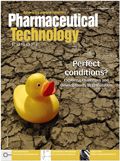One-Pot Processing And The Benefits For Granulation
Pharmaceutical Technology Europe
One-pot processing is a term that includes any technology that combines different unit operations of a pharmaceutical production process into one machine.
One-pot processing is a term that includes any technology that combines different unit operations of a pharmaceutical production process into one machine. In most cases, however, a onepot processor refers to a high shear mixer–granulator that is also equipped with drying technologies. Thus, onepot processing is the production of pharmaceutical granules using a wet granulation process in which dry mixing, liquid addition, wet granulation, drying and sizing of the granules is all performed in one machine.
Griet Van Vaerenbergh

The benefits of this type of processing are:
- By integrating granulating and drying capabilities into a single unit, capital investment in equipment and GMP floor space is lower compared with other alternatives.
- The number of material handling steps is decreased. Consequently, the total processing time is shorter while maintaining a high yield and keeping production support to a minimum. At the same time, the number of required operators is also reduced.
- Environmental variables, such as humidity, are eliminated from the manufacturing process, which may offer advantages for processing moisture-sensitive formulations.
- Requirements for solvent recovery systems are lower compared with fluid bed dryers.
- Reaching a high level of containment is easy by application of the correct measures at in and outlet valves.
- A single pot can be changed over in less than 2 hours, which makes it a very attractive technology if a large number of different products demanding a high number of product changeovers has to be produced.
Single pot processing has always been a niche technology in the pharma industry, but interest has increased in recent years because of the advantages it offers for producing highly potent compounds, such as oncology medicines and hormones. The concept of a onepot processor in itself already ensures contained processing. Because all unit operations are combined into one machine, the product is completely contained from charging the raw materials up to discharging the dry granulate ready for compression. No product transfers during the process are required, thus drastically reducing the exposure risk. By applying the correct containment measures to loading and discharge valves, a high level of containment is easily achieved.
Process variations
One-pot processors can be based on top or bottomdriven high shear mixer–granulators. The difference in the granulation process between a top and bottomdriven high shear granulator is not dramatic. With both types of granulator producing high quality granulates. Technically, however, with top-driven machines, the seals are outside the product, which can have GMP advantages.
The main difference between onepot systems lies in the drying technologies they offer.
The basic drying system for all onepot processors is vacuum drying (with heated bowl walls to supply the necessary drying energy). The advantages of vacuum drying include low drying temperature and ease of recovering the granulation liquid, as the vapours are not diluted with air and can easily be recovered by condensation. This is particularly advantageous when organic solvents are used for granulation; the emission of organic solvent vapours is very restricted in most countries, but vacuum drying technology allows companies to comply easily with environmental regulations.
The main drawback of 'pure' vacuum drying is that the supply of drying energy is limited to the surface of the bowl in contact with the product. For water-based products, especially when producing large batches, this results in long drying times at the detriment of the granulate quality. 'Pure' vacuum drying is therefore mainly advised for smaller batches and for solventbased granulations.
Different options are available to complement the single pot processor to help overcome the drawback of 'pure' vacuum drying. Many manufacturers offer some type of gas stripping during vacuum drying: a flow of inert gas is passed through the product during the drying phase to enhance the process. Although gasstripping technology will help to reach lower final moisture levels compared with vacuum drying, its effect on drying time will not be dramatic because the drying energy is still only supplied by the heated jacket of the bowl, so is still related to the available contact surface. This means that gasstripping technology is still only applicable for smaller, water-based batches. The technology is also less suitable for solventbased formulations because the vapours become diluted with non-condensable gasses, which makes 100% recovery more difficult.
Finally, some manufacturers offer microwave drying on single pot processors. This is the only technology that brings additional energy to the process and is, thus, able to significantly reduce drying times. For water-based formulations, microwave drying technology is the method of choice if a single pot process is considered. Another advantage of using microwaves during drying is that the temperature of the bowl jacket can be controlled because it is not required to supply the drying energy. This means that there is a lot more freedom to optimise the yield of a process, as the temperature of the jacket can be set at the correct temperature to avoid product sticking, without influencing the drying time.
The main drawback of microwave drying is that it is a relatively complex process, and requires both formulators and operators to have a good understanding of the process to ensure that it is developed and executed correctly. Fortunately, all experienced manufacturers of microwave equipment also offer extensive process support.
Recent advances
The first onepot processors were developed in the late '80s, but the biggest advances in process technology were made in the '90s with, for instance, the introduction of microwaves. In my opinion, the biggest advances in the field of one-pot technology in the last decade have been made in process control, containment and cleanability.
As many new applications handle potent oncology medicines, the machines require containment. This doesn't just mean the addition of high containment valves for loading and discharging; it also requires there to be contained sampling when producing validation batches or during production.
CIP is an integral part of a good containment strategy that avoids any contact between the operators and the product. Today, systems are on the market with validatable CIP.
As for many technologies, the implementation of PAT is gradually becoming a given for onepot processes. Nevertheless, there are still some challenges that need to be overcome in this area relating to reliability of the data capture (e.g., due to sticking of the product) and the interpretation of the results.
The most advanced systems on the market now have a special PAT probe that can monitor blend homogeneity, granulation liquid distribution, granulation endpoint and humidity. The probe can be cleaned during the process to prevent the product from sticking to the windows.
The regulatory hurdles to change to a one-pot process are no different to changing any other production method: SUPAC guidelines must be followed to determine what level of change is represented by the switch to a onepot process. For example, if the product is currently produced in a high shear mixer and dried in a tray dryer, the level of change for the unit operation of granulation will be level one because there is no change in the type of equipment (a one-pot processor is a high shear mixer). For the drying unit operation, the change will be level two, but this would be the same if the process was changed to a high shear mixer–fluid bed dryer process.
Griet Van Vaerenbergh is Product Manager Single Pot Processing at GEA Pharma Systems – Collette.
This article is part of a special feature on granulation that was published in the March issue of PTE Digital, available at www.pharmtech.com/ptedigital0311

Drug Solutions Podcast: A Closer Look at mRNA in Oncology and Vaccines
April 30th 2024In this episode fo the Drug Solutions Podcast, etherna’s vice-president of Technology and Innovation, Stefaan De Koker, discusses the merits and challenges of using mRNA as the foundation for therapeutics in oncology as well as for vaccines.
Pharmaceutical Tariffs Are Imminent: How Industry is Bracing for Impact
April 16th 2025On April 14, 2025, the Trump Administration launched a national security-driven investigation into pharmaceuticals, a move that will likely result in tariffs being placed on pharmaceutical drugs, ingredients, and other components that are imported from outside of the United States.